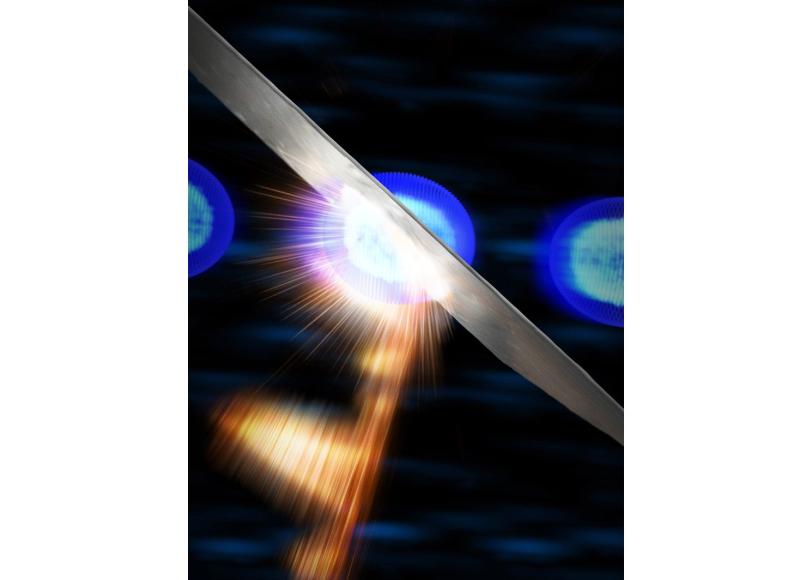New Life for Old Electrons in Biological Imaging, Sensing Technologies
Using leftover high-speed electrons from SLAC’s Linac Coherent Light Source, researchers have successfully generated intense pulses of light in a largely untapped part of the electromagnetic spectrum – the so-called terahertz gap.
By Janet Rae-Dupree
Using leftover high-speed electrons from SLAC’s Linac Coherent Light Source, researchers have successfully generated intense pulses of light in a largely untapped part of the electromagnetic spectrum – the so-called terahertz gap.
Terahertz pulses – T-rays, for short – get their name from their frequency, which is 1 to 10 trillion cycles per second. Falling between visible frequencies and microwaves on the electromagnetic spectrum, terahertz waves are being used in new sensing technologies and biological imaging techniques that cause minimal radiation damage to samples.
Other potential uses include chemical and biological materials identification, photonic devices, microelectronics characterization and biomedical imaging. Until now, however, the quest to develop many of these applications has been frustrated by an inability to produce terahertz light that’s bright enough.
A team led by SLAC National Accelerator Laboratory’s Aaron Lindenberg reported success in a paper published Oct. 7 in Applied Physics Letters.
“We’ve generated terahertz light pulses with field strengths comparable to the forces that hold atoms together in materials or exist within nanoscale devices,” said Lindenberg, a member of the Stanford PULSE Institute for Ultrafast Energy Science, and SIMES, the Stanford Institute for Materials and Energy Science. “It’s a big leap forward in terms of the magnitude of the electromagnetic fields that we’re generating." The work was a collaborative effort between investigators in photon science and the LCLS at SLAC.
The LCLS generates intense X-rays for research by accelerating electrons and sending them wiggling through magnets. Once their work is done, the still-speedy electrons are shunted off to a particle dump.
But Lindenberg and team thought of a clever way to reuse these electrons: They sent the electrons, which are gathered into breathtakingly short bunches only 100 millionths of a billionth of a second long, through a thin metallic foil. The electrons in the metal responded by radiating in phase with each other, emitting short, coherent bursts of terahertz light.
Because these LCLS bursts are so short – comparable to the duration of a single cycle of the terahertz light wave, from peak to peak or trough to trough – they might be used to investigate and even control the functional properties of materials, said Lindenberg, an assistant professor of materials science and engineering, and of photon science, at Stanford.
Beyond their potential for sensing and imaging, terahertz pulses create electric and magnetic fields that are capable of pushing atoms in specific directions, he said. These fields could be used, for example, to push electrons or ions within a solar cell or electrochemical device in order to study the first stages of processes within them.
“In this paper, we’ve demonstrated the source and observed some first exciting examples of how these intense fields interact with materials. The next step is to apply this,” Lindenberg said. “We’re also interested in using these kinds of fields to understand how fast ferroelectric materials can switch their polarity, which is important for developing materials for next-generation information storage technologies, and understanding their photovoltaic response. You can use these kinds of single-cycle fields to study these intrinsic properties in ways never before possible.”
Using both the high-intensity terahertz fields and the LCLS X-rays simultaneously, “you could additionally probe with the X-rays to visualize what the atoms are doing,” Lindenberg said.
Other groups at SLAC already have expressed interest in using these new fields to manipulate surface chemistry. They could be used to snip a bond that binds atoms to the surface of a material, either to eject it from the sample or to drive it along the surface and control chemistry in defined ways.
“Imagine you could take two atoms on a surface, push them together, and cause them to form a bond on an extremely short time scale,” he said. “What would happen? It depends on the system, but no one really knows because no one has ever been able to do these kinds of things before.”

(Image by Greg Stewart, SLAC InfoMedia)